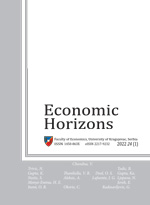LABOR PRODUCTIVITY IN THE SELECTED SEE COUNTRIES: TRENDS AND DETERMINANTS
Predrag Trpeski, Kristijan Kozheski and Gunter Merdzan
University “Ss. Cyril and Methodius”, Faculty of Economics Skopje, North Macedonia
This study examines labor productivity in the Open Balkan initiative countries (Albania, Serbia, and North Macedonia) and Southeastern Europe’s latest EU entrants (Bulgaria, Romania, and Croatia). In the study, macroeconomic and institutional factors, including the Gross National Income (GNI) per capita, the unemployment rate, the statutory minimum wage, and the labor freedom index are analyzed in relation to labor productivity. The study used econometric methods to identify the labor productivity determinants and discern the labor market differences between the two groups of countries. The key findings emphasize the pivotal role of economic development in Southeastern Europe, especially among the last EU entrants, fostering additional increases in labor productivity. The study reveals the significant influence of the labor freedom index on productivity, with nuanced implications for both groups of countries. Additionally, it highlights the tangible impact of the statutory minimum wage policies on labor productivity in the Open Balkan initiative countries, indicating potential shifts in the wage structures and broader economic landscapes. The interplay of variations in the unemployment rate emerges as a substantial factor shaping efficiency and overall productivity in the labor market across both groups. These findings provide valuable insights into the labor market complexities faced by the Open Balkan countries, underscoring the need to bridge the gaps for economic development catch-up.
Keywords: labor productivity, unemployment rate, Open Balkan initiative, Southeastern Europe
JEL Classification: J21, J31, J88




